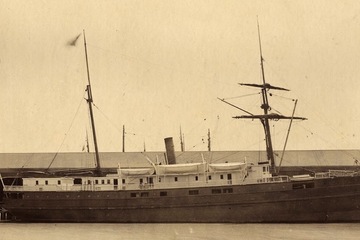News
19th Century Shipwreck Rediscovered In San Francisco

The lost shipwreck of a passenger steamer that went down near the Golden Gate in San Francisco has been rediscovered.
The National Oceanic and Atmospheric Administration (NOAA), announced the discovery of the remains of the SS City of Chester on Wednesday. NOAA’s Coast Survey Navigational Response Team 6 discovered the wreck last year during a sonar survey of the San Francisco Bay.
The City of Chester was built in 1875 and sank in 1888. Carrying 90 passengers, the ship was steaming away from San Francisco toward Eureka, Calif., on Aug. 22 of that year. The fog that day was dense.
Only a few minutes into the voyage, around 10 a.m., the City of Chester was traveling through the Golden Gate, the entrance to San Francisco Bay that is now spanned by the Golden Gate Bridge. The ship was struck by the Oceanic, another ship arriving at the harbor from Asia.
The City of Chester lasted only six minutes before the ship sunk, according to NOAA. Sixteen people died in the wreck, and the public initially raised a racially charged outcry against the Asian immigrants on the Oceanic. Stories of those passengers’ heroism in saving victims on the City of Chester soon dampened those cries, however.
The wreck’s location in the aftermath of the sinking was no mystery, said James Delgado, the director of maritime heritage for NOAA’s Office of National Marine Sanctuaries. In 1888, the now-defunct U.S. Coast and Geodetic Survey dragged a wire behind a tugboat and snagged the hull of what they believed to be the City of Chester. Salvage diver Capt. Robert Whitelaw also claimed to have sent a diver to the shipwreck in 1890. Whitelaw reported that the ship was cut nearly in two by the Oceanic’s blow.
The diver “said there were bodies in the wreck, and it spooked him and he didn’t want to go back,” Delgado told Live Science.
But over the years, the wreck was largely forgotten, except as a footnote as the second-deadliest maritime disaster at the Golden Gate. In May 2013, NOAA’s Coast Survey team was conducting a sonar survey in preparation for the America’s Cup yacht race, Delgado said. He asked the team to venture into the area where the City of Chester might have gone down.
The team was able to find the ship, “zoom in” with sonar and survey it. The survey revealed 202-foot-long (62 meters) City of Chester sitting upright at the edge of a shoal in 216 feet (66 m) of water, “shrouded in mud,” Delgado said.
The hull rises 18 feet (5.5 m) from the ocean floor, and high-resolution sonar even located the gash from the collision on the port side of the ship, NOAA reported.
The discovery highlights the use of science and technology in ocean exploration, Delgado said, adding that he hopes the mission inspires young people to study science.
“Not only are we boldly going and finding new life [in the oceans],” he said, “we’re finding evidence of past civilization.”
There are no plans to raise the wreck, and the strong currents and murkey water at the Golden Gate make diving to the wreck a dangerous proposition, Delgado said. NOAA intends to create an exhibit about the ship at the office of the Gulf of Farallones National Marine Sanctuary at Crissy Field in San Francisco and will also work with Google Oceans to put information about the wreck online, Delgado said.
Source: www.livescience.com
News
Book Review: Fire on Monroe Bravo by Fred Lockwood

Fire on Monroe Bravo is the latest book in the Jack Collier series by Fred Lockwood. Our story begins with our lead characters, Jack and Sandro, owners of Marine Salvage & Investigation Company, arriving on the Monroe Bravo Oil & Gas Platform in the North Sea. Having secured a contract for their vessel the MV Stavanger to act as support ship to the platform for TransGlobal Oil, our protagonists are on a celebratory visit.
However almost as soon as they arrive a series of explosions rock the platform, causing huge damage, loss of life and the very real danger of a massive human, ecological and financial disaster.

As the danger mounts for both our heroes and the surviving workers, Jack and Sandro will have to escape the inferno, all while trying to save the platform and the men still trapped unable to help themselves.
The disaster sets the scene for the unfolding story lines following the fate of the platform and our main characters, the police investigation into a suspected terrorist act and the actions of TransGlobal Oil as they attempt to navigate the pubic outcry and financial repercussions.
In his eighth book, Fire on Monroe Bravo, Fred Lockwood delivers an explosive thriller, with plenty of above and in-water drama, and our heroes fighting for survival, what more can you ask for?
We thoroughly recommend this read and look forward to the next in the series. For more information about his book series, you can check out the reviews of his previous books here on Scubaverse.
- Title: Fire On Monroe Bravo
- Author: Fred Lockwood
- ISBN: 979-8325324536
Available in a paperback version and for Kindle from Amazon and book stores.
Blogs
Alonissos: The complete diving destination (Part 1)

In June we were incredibly fortunate to be invited to dive in Alonissos, a small Greek Island in the Sporades island chain located in the North Aegean Sea. While I have long been a big fan of the Greek Islands as a great holiday destination, I had not had the opportunity to do any diving on previous visits and Mike and I were extremely excited to see what Alonissos had to offer both above and below the surface!

The Sporades are easily accessible via the airport in Skiathos (the first island in the chain), which is served by Jet2 flights from all major UK airports from May through October. Numerous ferries and charter boats make island hopping from Skiathos Town a breeze. After an hour boat ride, the picturesque port of Patitiri was a wonderful introduction to Alonissos, where we were met by our gracious hosts Kostas of Albedo Travel and Dias of Alonissos Triton Dive Center. Mike and I were delighted to be staying at the Paradise Hotel, aptly named for its stunning views over the sea and great location for walking to the waterfront.

Alonissos is beautifully situated in the National Marine Park of Alonissos and the Northern Sporades, the largest marine protected area in Europe. The surrounding seas offer fabulous marine life, including incredibly rare species such as the Mediterranean monk seal. They boast deep walls covered in gorgonians and sponges, stunning topography with caverns, swimthroughs and pinnacles, and the first accessible ancient shipwreck from 500BC!

In locations where historical sites have been reported, the waters are largely restricted, but with collaboration between government, underwater archeologists and dive centres, incredible underwater museums are being created for a truly unique diving experience. Alonissos is home to the first of these, the Ancient Shipwreck of Peristera Accessible Underwater Archeological Site. The chance to dive into history (along with reports of healthy reef life and amazing underwater topography) meant Mike and I were keen to get in the water.

Our introduction to the diving around Alonissos was at the Agios Georgios Pinnacles, in the channel between Alonissos and Skopelos. This fantastic site was named “The Chimney,’ and proved to have a huge amount to see. We got to a decent depth here (over 25m), and marvelled at a colourful reef wall with a wonderful swim through whose rocky walls were absolutely covered with life. As well as brilliant topography there was no shortage of macro life here. We saw numerous nudibranchs, five different species in total. The second dive at Mourtias reef nearby was a shallower dive along a nice wall with lots of crevices. Several moray eels and grouper called this site home. We enjoyed looking in the crevices for lobster and smaller benthic life, such as cup corals and tunicates.

Our itinerary allowed us two dives a day with afternoons left to explore the island with our hire car and evenings to enjoy the famous Greek hospitality. This proved to be a lovely mix of in-water and land based diversions.

The next days diving to the Gorgonian Gardens and Triton’s Cave was to be even better! These two stunning sites are nothing short of fabulous. The Gorgonian Gardens was a deep wall near to the Agios Georgios islands. The ever-present currents in this deep channel meant that the sea life was amazing … the namesake Gorgonian sea fans dotted the wall at a depth of 30 to 50 meters, getting ever larger the deeper we went. Above 30m was by no means less beautiful, with sponges, corals, scorpionfish, moray eels and some rare and colourful nudibranchs.

The second shallower dive of the day was to Triton’s Cave or the Cavern of Skopelos, on the east side of that island. The spectacular rock formations had wild striations both above and below the water making a truly epic topography. The cavern entrance was at 14m, and big enough for a buddy pair, winding up to 6m and passing two beautiful windows out into the blue. Emerging from the cavern, the light at the shallower depths and the incredible rock formations made for a fantastic gentle swimming safety stop and we all surfaced by the boat with massive grins.

Check out our next blog :Alonissos: The complete diving destination (Part 2)” to hear about our amazing dive on the 2500 year old Peristera Wreck!
Thanks to:
Alonissos Triton Dive Center https://bestdivingingreece.com/
Albedo Travel https://alonissosholidays.com/activities/
Paradise Hotel https://paradise-hotel.gr/
Alonissos Municipality https://alonissos.gr/en/
-

 Blogs2 months ago
Blogs2 months agoDiving With… Nico, Ocean Earth Travels, Indonesia
-

 News1 month ago
News1 month agoMurex Bangka Announce New Oceanfront Cottages & Beachfront Dining
-

 Blogs2 months ago
Blogs2 months agoA new idea in freediving from RAID
-

 Marine Life & Conservation1 month ago
Marine Life & Conservation1 month agoIceland issue millionaire whale hunter a licence to murder 128 vulnerable fin whales
-

 Marine Life & Conservation2 months ago
Marine Life & Conservation2 months agoThe Shark Trust Great Shark Snapshot is back
-

 News3 months ago
News3 months agoCharting New Waters; NovoScuba Goes Global with the Launch of their Revolutionary Dive Training Agency!
-

 Gear News1 month ago
Gear News1 month agoNew Suunto Ocean – a dive computer and GPS sports watch in one for adventures below and above the surface
-

 Marine Life & Conservation Blogs2 months ago
Marine Life & Conservation Blogs2 months agoBook Review: Plankton















